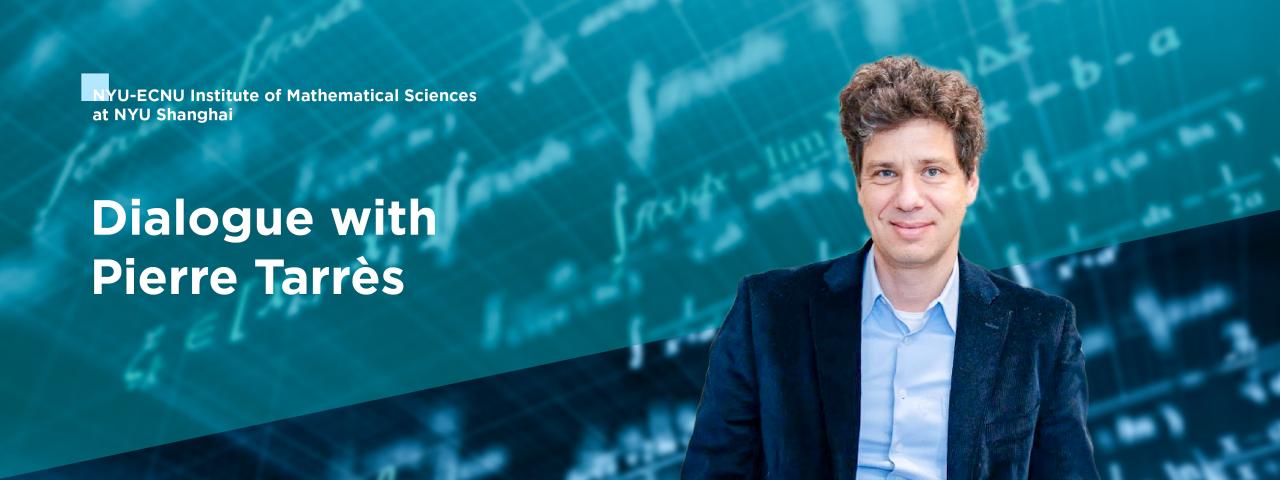
Since its establishment in 2013, the NYU-ECNU Institute of Mathematical Sciences at NYU Shanghai has succeeded in attracting a robust faculty team of distinguished mathematicians and scientists who are broadening the spectrum of mathematical topics at NYU Shanghai. Working in close partnership with NYU’s Courant Institute of Mathematical Sciences and East China Normal University’s Department of Mathematics, the Institute is dedicated to advancing the theories and applications of probability, nonlinear partial differential equations, fluid dynamics, biology, materials science, computational neuroscience, and mathematical finance. NYU Shanghai’s Associate Provost for Strategic Initiatives Pierre Tarrès, the Institute’s co-director, shares how the institute has evolved.
How has the Institute grown over the years?
In a first phase, several established professors from Courant Institute, including Gérard Ben Arous, Fanghua Lin, David Mc Laughlin and Chuck Newman, spent long periods of time at NYU Shanghai with the objective of attracting distinguished visitors, both for research visits and for longer-term visiting positions, and to hire the first tenured faculty, Vladas Sidoravicius and myself. It proved to be very successful–we soon started to get a lot of recognition as an international center in mathematics.
We have had the pleasure of hosting prestigious colleagues at our seminars and conferences, including two Fields medalists, Hugo Duminil-Copin (IHES and Geneva) and Wendelin Werner (Cambridge) and, amongst others, Tom Spencer (Institute of Advanced Studies, Princeton), and Alain-Sol Sznitman (ETH Zurich), each who came to visit for extended periods of time.
From around 2019, the Institute has been able to build on that strength and structure itself around long-term goals: consolidate the faculty, both at tenured and tenure-track level, set up a doctoral program jointly with Courant Institute, expand to other areas of expertise while reinforcing our domain of focus, motivate applications, and collaborate with other groups, in particular in neuroscience, data science, and physics. The pandemic showed us the need for a more stable group of colleagues and more internal structure within mathematics and the University, because international visits were made much more difficult for three years. Another objective has been to broaden our mathematical spectrum and hire in other areas.
Despite the adverse conditions created by the pandemic, we hired a group of six new tenured and tenure-track colleagues of strong international standing in mathematics. We are also very excited to have Nobel Prize Laureate in Economics Tom Sargent join us and collaborate with Mathieu Laurière and myself on a new project on strategic interactions at the interface of mathematics and economics, using tools from mean field game theory.
Now that our group is sufficiently large and diverse, we can launch a third phase, where we will further build the graduate school, and create new partnerships both within and outside NYU Shanghai and ECNU.
How do affiliations with NYU Courant and ECNU influence or inform the Institute?
Our institute is indeed the result of joint efforts of these three institutions, which are at the core of its DNA. The three entities enrich us in different ways.
NYU Shanghai enables us to easily hire distinguished visitors and faculty who stimulate our research team. Courant Institute, which is much bigger than we are, provides us with expertise on candidates, areas to develop, suggestions of scientific events, and long-term visitors in areas we would like to represent more, and all those factors help us attract first-rate colleagues. ECNU provides us both with a key cooperative interaction with a Chinese university, but it is also complementary in the topics of research–while NYU Shanghai has a strong focus in probability and mathematical physics, ECNU is a key element in helping us attract colleagues in PDEs, geometry, and algebra.
Probability and Mathematical Physics is and will remain a strong area of focus at NYU Shanghai, and this owes to the impact of the support and long-term visits from Gérard Ben Arous and Chuck Newman from Courant Institute.
Partial Differential Equations is also central in our institute, and this owes a lot to the long-term visits of Fanghua Lin, and to ECNU, where it was already a strong component. We still need to reinforce that area by ideally hiring at least one tenured faculty at NYU Shanghai, preferably at senior level, who will join Mathieu Laurière, Vahagn Nersesyan, and Wei Wu, who are partially working on those topics.
We have now expanded to Applied Mathematics, which is a strong component at Courant Institute. Mac Huang and Zhuo-Cheng Xiao joined us, respectively jointly with Physics and with Neuroscience, as tenure-track faculty, while Jun Zhang continues to be very active at the interface of Mathematics and Physics. Geometry and algebra are also represented at NYU Shanghai, although we must of course reinforce those dynamics with the help of ECNU and Courant Institute.
What are some distinct features of the Institute?
One of the most striking illustrations of our simultaneous strong connection both to the Western world and to Asia, mainly China, is our undergraduate Honors Mathematics program. Our instructor group is international, but so far, a large majority of our students taking it have had a Chinese high school education, probably because mathematics is a strong area of focus in Chinese schools. I believe the mix of interaction of those two very different systems, the Chinese and the Western, benefits them enormously. A significant number of them do their graduate school at prestigious universities, such as Cambridge, Columbia, Harvard, Princeton, MIT, and of course Courant Institute! The success of our Honors Mathematics program has been recognized with a prestigious First Prize under Shanghai City’s Education Excellence Award in 2022, and one of our goals is to strengthen our graduate school to be able to attract more strong students at that level.
That position at the nexus of two different worlds is also a strong asset in research, as we attract the interest of both internationally renowned colleagues from the western world, and at the same time we create long-term relationships with Asian institutions. This is of course the case with Chinese universities and research centers beyond ECNU, such as the Chinese Academy of Sciences, Jiao Tong, Fudan, ShanghaiTech, Peking,Tsinghua and BIMSA. We have also created regular joint workshops with Kyoto and Waseda in Japan, and with Singapore, Bangalore, and NYU Abu Dhabi, and we are currently organizing a joint event in Hangzhou this spring with our colleagues from Peking University.
That interaction greatly strengthens us, because of the research dynamics it creates, and because it also creates opportunities to attract colleagues connected to those institutions. Of course, that dynamic goes both ways, and we are also glad to see some long-term visitors join those partner institutions, as that deepens our network.
What research are current faculty members involved with?
Our research interests are very diverse, and they are difficult if not impossible to summarize in a few lines. I will describe a few of them, but I should insist that those hardly represent all the variety of themes represented by the Institute activity. The first one concerns random walks in random environment and self-interacting random walks, which have been introduced as models the study of the movement of a particle in a highly disordered and inhomogeneous medium, and used for instance as a model of DNA chain replication and crystal growth, or turbulent behavior in fluids through a Lorentz gas description (Sinai 1982). In general they provide powerful models for a variety of complex large-scale disordered phenomena arising from fields such as physics, biology and engineering, and are studied in particular by Alejandro Ramirez (currently Area Head for Mathematics) and myself. The second one concerns percolation and interface models, such as Ising, XY, Villain, Dyson models, which were introduced as mathematical models of ferromagnetism in statistical mathematics, and it is an area in which Wei Wu and Roberto Fernandez contribute actively.
Another important theme in our institute is the study of Partial Differential Equations (stochastic or not), which are ubiquitous in mathematics and model phenomena ranging from the diffusion of heat and sound, fluid dynamics, liquid crystals, or quantum mechanics, for instance. Those themes are studied by Fanghua Lin, Yuning Liu, Vahagn Nersesyan, Wei-Min Wang and Feng Zhou (co-director of the Institute at ECNU) for instance.
Some of us are also working on new themes from Data Science, particularly in machine learning, non-convex optimization, spectral graph theory, deconvolution and compressive sensing, group synchronization, control and games with large populations of agents, in the context of crowd motion, epidemic control and neural networks, or mathematical questions arising from Neuroscience. I would mention the work of Shuyang Ling, Mathieu Laurière, Jun Zhang, Mac Huang and Zhuo-Cheng Xiao in that area.
Another theme represented in the Institute, and considered by Jun Zhang and Mac Huang, is the experimental component of fluid dynamics, geophysics and soft matter physics, in particular on fluid-structure, interaction questions like dissolution, falling and thermal convection.
I should finish by mentioning the work done by the colleagues Nadir Matringe and Shengkui Ye working on algebra, such as representation theory and number theory, and low-dimensional topology.

